This post is also available in: Español
This authentic Guatemalan recipe for tamales negros is easy to follow and includes step-by-step instructions for making Guatemalan tamales negros (black tamales). These slightly sweet tamales are a popular traditional Guatemalan dish enjoyed during the holiday season. They get their name from their dark mole sauce, and along with the tamales colorado are usually enjoyed on Noche Buena and during other important holidays like Las Posadas and Año Nuevo (New Year).
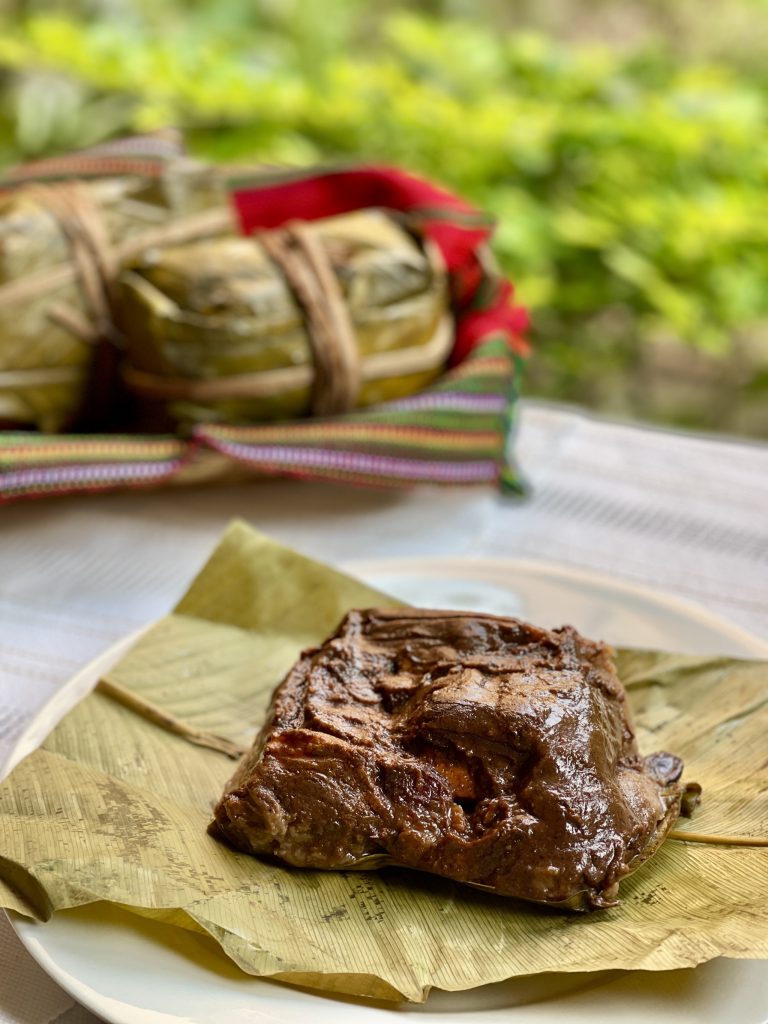
Adding cinnamon, sugar, and chocolate to the sauce, the sweetened dough, and the decorative touches of raisins, almonds, and prunes make them an irresistible option for those with a sweet tooth like mine. Making these tamales in Florida, I’m transported back to the holiday celebrations in Guatemala, surrounded by family and the rich, comforting flavors of home.
Memories of Christmas in Guatemala
I grew up eating tamales negros on Christmas Eve. Then when my parents got divorced, we would have ham for Christmas Eve at my mom’s, and then I would have tamales negros at my dad’s for Christmas Morning brunch along with tamales colorados. I always have my tamal colorado first and then finish off with the tamal negro, always accompanied by some pan francés, or shecas and a glass of horchata or chocolate caliente, depending on whether it’s cold that day or not. And to finish off our Christmas meal we always have buñuelos or rellenitos de platano.
When I moved to Florida, one of the hardest things was being away from my family during the holidays. Making tamales negros at home during the holiday season makes me feel closer to my family and brings back so many memories. I feel transported from the moment the sweet recado sauce fills the house with that unique scent of chocolate and cinnamon notes. ( In Guatemala, the sauce, even though it’s chocolate-based and similar to Mexican mole, is not called mole but recado).
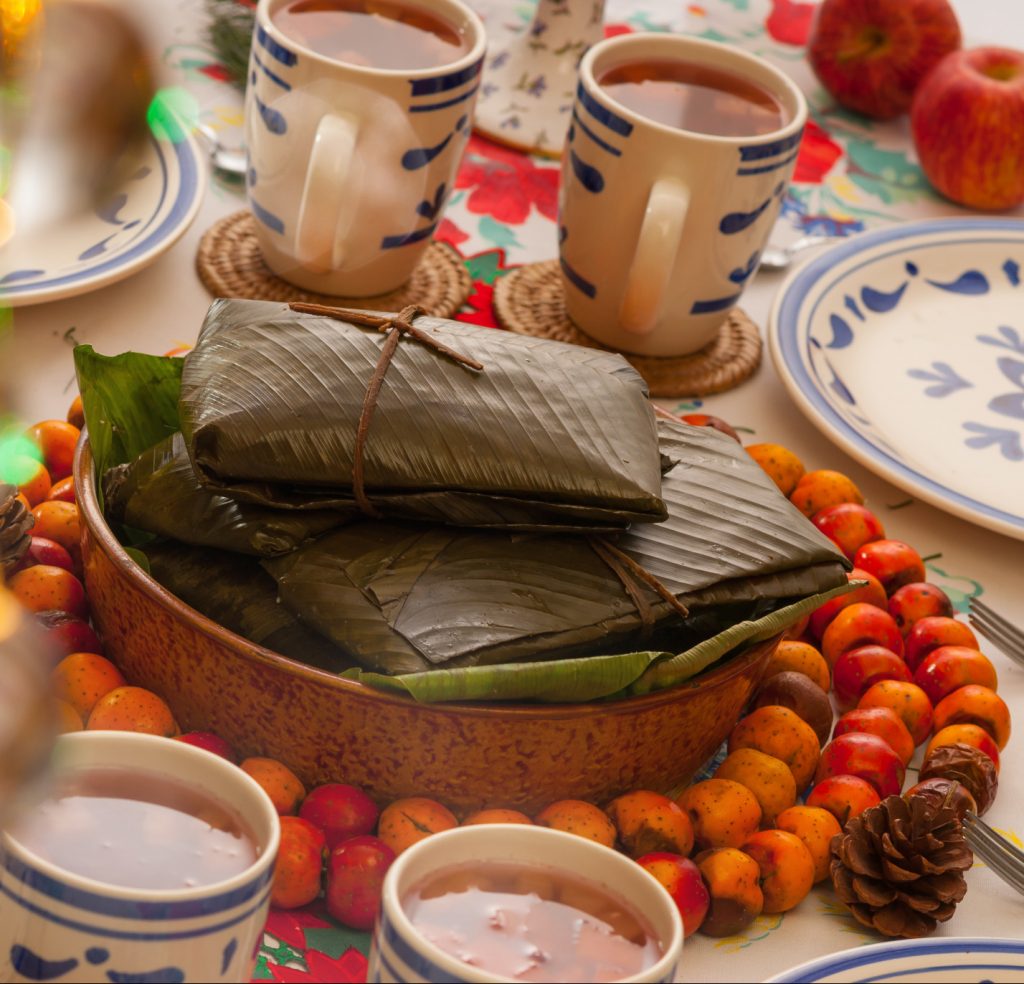
So if you, like me, are away from Guatemala and want to make tamales negros this holiday season, I hope that you find this recipe similar to those tamales negros that bring back memories and make you feel close to your Guatemalan roots and family. And if you have never tried tamales negros, well, you are in for a real treat! These tamales are probably like no tamal you’ve tasted before; they are truly special and festive.
What are Tamales Negros?
Guatemalan Tamales Negros are a distinctive and cherished part of the country’s culinary traditions, especially during the holiday season. These tamales are known for their deep, rich flavor, primarily stemming from their unique sauce – a complex and sweet mole made with chocolate.
The dough, or ‘masa,’ is infused with a blend of spices and chocolate, creating a subtly sweet and earthy base. The sauce, often a blend of tomatoes, peppers, and a variety of spices, including cinnamon, is enriched with dark chocolate, contributing to the tamale’s signature ‘negro’ or black color. Typically, they are filled with a mix of meat (pork or chicken), prunes, raisins, and olives, creating a delightful balance of sweet and savory flavors. The tamales are then wrapped in banana leaves, which give them a sweet and fresh note, and steamed to perfection. The result is a rich, complex flavor that is comforting and synonymous with the holiday season.
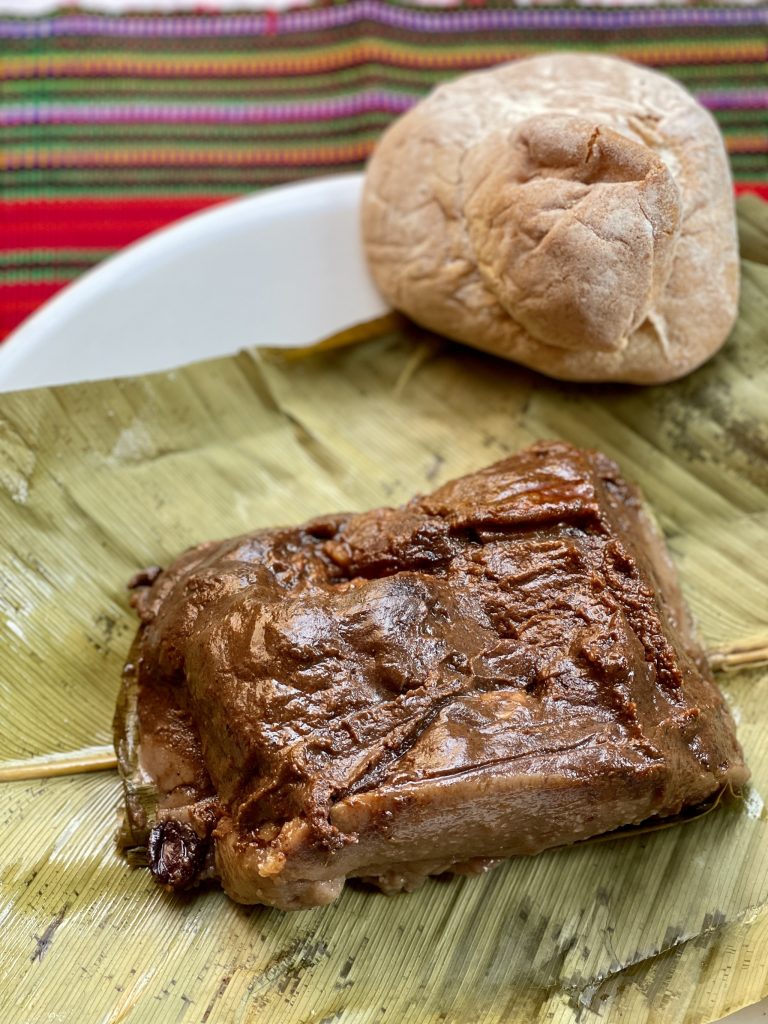
Where do these Sweet Tamales Come From? The History of Guatemalan Tamales Negros
The history of Guatemalan Tamales Negros dates back to the pre-Columbian era, deeply rooted in the rich cultural and culinary traditions of the Mayan civilization. They represent a fusion of indigenous and Spanish influences, a culinary evolution that began with the arrival of the Spanish in the 16th century. The indigenous people of Guatemala had long used corn, a staple in their diet, to make various dishes, including tamales. The introduction of European ingredients like raisins, olives, and capers, combined with the native use of chocolate, chili peppers, and spices, led to the creation of what is now known as Tamales Negros. Over time, these tamales have become a symbol of Guatemalan cuisine and a centerpiece in festive celebrations, especially during Christmas and New Year’s Eve, signifying a blend of history, culture, and flavors passed down through generations.

How to Make the Best Guatemalan Tamales Negros
I want to share my tamal negro recipe, but before I do, I want to clarify that this is my family’s recipe. This makes these tamales negros recipe the best tamales negros recipe for me. That being said, every family has their own recipe for tamales, and each family makes tiny or not-so-tiny variations to their tamal recipe. If you’ve ever had tamales negros before, especially if they were made by your mom, your tia or your abuela these tamales will probably not be exactly like those tamales you remember.
For example, I’ve heard many people add almonds or a sliver of sweet bell pepper to their tamales negros, I’ve never had tamales negros with almonds or bell pepper. However, I did add a few variations at the end of the recipe, so you have some options.
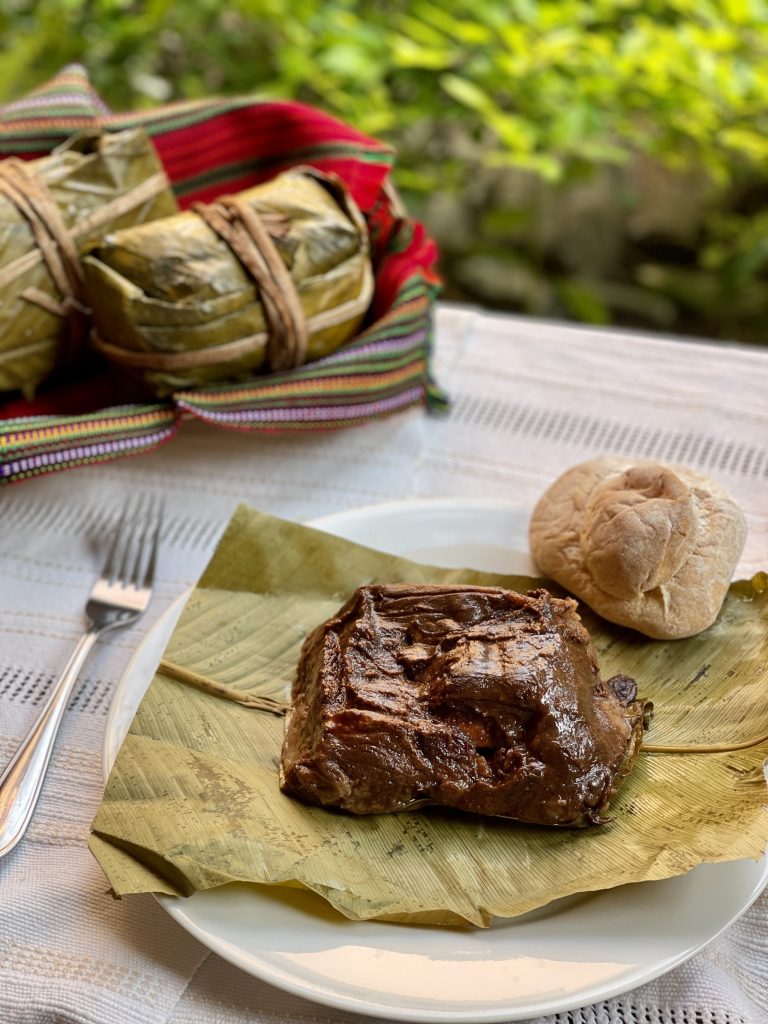
Not only might this recipe be slightly different from those tamales negros you remember having, but it lacks that special touch, that family recipe status, that flavor that comes from connections and is tied to memories. But if you’re here, that means you probably do not have that family recipe, so here is your chance to make this recipe your own. Make a tamalada and include your kids or teens or adult children, your friends, and your tias too. Heck, include your husband and create a new family tradition and make this Guatemalan tamal negro recipe your own. Find your own personal and family’s best Guatemalan tamal negro recipe and use this recipe as your starting point.
Guatemalan Sweet Tamales: Tamales Negros Recipe
Yields: 30 tamales
Ingredients
For the Dough:
- 4 lb of prepared salpor corn dough like Maseca (or any corn flour)
- 1 lb of prepared rice flour
- 1 ½ lb of lard for the dough
- 2 ½ lb of sugar
- 4 cups of water (for the dough)
Ingredients for the Meat Filling:
- 2 lb of pork meat (or chicken)
- 1 tablespoon lard
- 1 teaspoon of salt
- 1 teaspoon of sugar
For the Sauce (Recado):
- 12 medium tomatoes
- 2 pasilla chiles
- 4 guaque or guajillo chiles
- 6 whole allspice berries
- 6 black peppercorns
- 1 stick of cinnamon (or a teaspoon of ground cinnamon)
- 4 cloves
- 3 oz of pumpkin seeds
- 2 oz of sesame seeds
- 4 tablets (8 oz) of grated Mexican chocolate (like Abuelita or Ibarra)
- 2 to 3 cups of water
- 6 level tablespoons of sugar
- 8 prunes
- ½ box of raisins
- 30 prunes
- 1 teaspoon of lard
- Champurrada bread crumbs to taste (only if necessary, to thicken)

For Assembling the Tamales:
- 30 cut banana leaves
- 30 cut maxán leaves
- 2 bunches of cibaque (string)
Preparation:
For the Dough:
- Dilute the corn dough with 2 cups of water, making sure to avoid lumps, in a large bowl that allows free movement.
- Separately, in another bowl, dilute the rice flour with a cup of water until smooth.
- Combine the two diluted doughs, adding the remaining 2 cups of water.
- Cook this dough, stirring constantly to prevent it from settling and sticking to the bowl. As it boils, add the indicated lard and sugar. Cook until well done and not too hard. Let it cool down.
For the Meat:
- Cut the meat into 30 cube-shaped pieces.
- Rub them with sugar and a pinch of salt. Then, fry them in a pan with a tablespoon of oil or lard. Keep them warm once done.
- I recommend using boneless chicken. If using chicken, the cooking time for the meat may vary as chicken cooks faster than pork. However, the cooking times for the tamales will be the same.
For the Sauce:
- Roast the tomatoes, allspice, chiles (seedless), cinnamon, and cloves in a pan; peel the tomatoes and set aside. Toast the pumpkin seeds and sesame seeds separately and set aside as well.
- After roasting and toasting, blend all these with the chocolate and 2 cups of water until you get a smooth sauce.
- Add 8 prunes, half a box of raisins, and 6 tbsp of sugar. Blend again until smooth.
- Fry this mixture in the same pan as the meat using 1 tbsp, of lard.
- Check for seasoning; add ½ cup of water and let it reduce. If necessary, use bread crumbs to thicken. Cook until you get a thick sauce consistency to prevent it from running.
How to Wrap Banana Leaf Tamales:
- Bend the side of the banana leaf nearest to you over the dough, then pull the side furthest from you towards yourself. This will form a narrow, elongated rectangle.
- Gently encase the dough by folding over one of the longer edges and then the other.
- Secure the package with the string, ensuring it’s snugly tied.
- Continue this process with the remaining dough and leaves.
- I prefer adding an additional aluminum foil layer around the banana leaf-wrapped tamales. This extra layer aids in the storage of the cooked tamales, whether you plan to refrigerate them for a short period or freeze them for later use.

Preparing the Pot:
- Once you finish preparing the tamales, take a large pot and cover the walls and bottom with leaves (this is known as “bed”). Place them inside.
- Add boiling water until it fills ¾ of the height of the tamales. Add 1 tablespoon of sugar.
- Cover them with more leaves and a plastic bag.
- Put the lid on pot and cook over medium-high heat for 50 to 60 minutes. Check the water level at 30 minutes of cooking. If necessary, add more hot water.
- Once the tamales are placed on the bed, the hot water you pour into the pot
- Under no circumstances should the pot run out of water. Otherwise, the pot will burn, the tamales will come out smoked, and the wrappings will be burnt.
- After cooking and testing tamales to see “how it turned out,” let them cool a bit so that the tamales set and the dough compact. Otherwise, the dough will be tasty but watery. One way to know if it’s done is to take one of the tamales out of the pot and give it a pat, it should sound hollow.

Variations:
- Add a slice of sweet bell pepper to the tamales before wrapping it.
- Add several almond slivers to the tamales before wrapping it.
- Use well-toasted French bread, even if it’s a bit burnt, instead of champurrada crumbs.
- If you can’t find champurradas, you can replace them with regular bread crumbs to thicken the sauce.
Prepare in Advance
This beloved Guatemalan recipe is one of my favorites, but it does take quite a bit of time to make. Plan ahead’s a good idea, as the whole process will take several hours. You can do it all in one day or save time by preparing parts of the recipe, like the recado sauce, beforehand.
If you’re using chicken for the filling, cook it the day before and store it in the refrigerator. But if you’re using pork, it’s better to cook it on the same day to avoid it becoming dry.
The dough should be made on the day you plan to assemble the tamales to keep it from getting too hard. However, preparing other components a few days in advance can help, giving you more time to put everything together and steam the tamales.
What is the Best Way to Freeze Tamales?
The best way to freeze tamales involves a few simple steps to ensure they remain delicious when reheated. First, let your cooked tamales cool to room temperature after steaming. Avoid freezing them while they’re still warm, as this can lead to condensation and ice crystals. Once cooled, wrap each tamale individually in plastic wrap or aluminum foil. This step helps to prevent freezer burn and preserve their moisture. Place the wrapped tamales in a freezer bag or an airtight container. Label the container with the date, as tamales are best used within three to six months of freezing. When storing in a freezer bag, remove as much air as possible before sealing to maintain freshness.
How to Store Tamales
Keeping tamales moist is key to store them, whether they’re leftovers or made in advance. After cooking, let them cool completely. If you plan to eat them within a few days, store them in the refrigerator in an airtight container or a plastic bag. If they are still in their husks, leave them wrapped as this helps retain moisture. For longer storage, follow the freezing method outlined above.
How to Reheat Leftover Tamales
Reheating leftover tamales can be done in several ways. The steaming method is the most traditional and helps to keep them moist. Simply place the tamales in a steamer basket over boiling water, cover, and steam for about 15-20 minutes until they are heated through. You can also microwave them for a quick option. Wrap the tamales in damp paper towels and heat on high for about two minutes. Check if they’re warm enough; if not, continue heating in 30-second intervals.
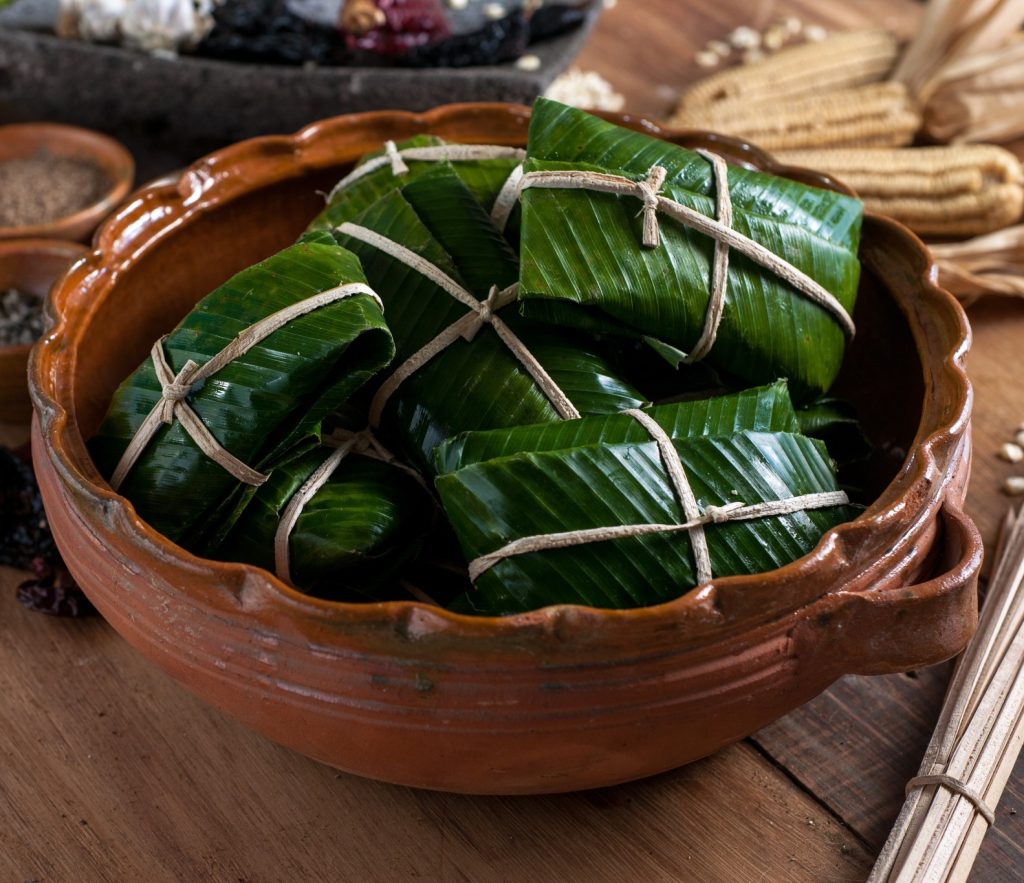
How to Reheat Frozen Tamales
Reheating frozen tamales is easy and doesn’t require thawing. The best method is steaming, which heats the tamales evenly and restores their original texture. Place the frozen tamales in a steamer basket over boiling water and steam for about 20-30 minutes. If you’re in a hurry, you can microwave frozen tamales. Wrap them in damp paper towels and microwave on high for three to four minutes. Check their warmth and continue heating in short bursts if needed. Remember, microwaving might not provide the same texture as steaming.
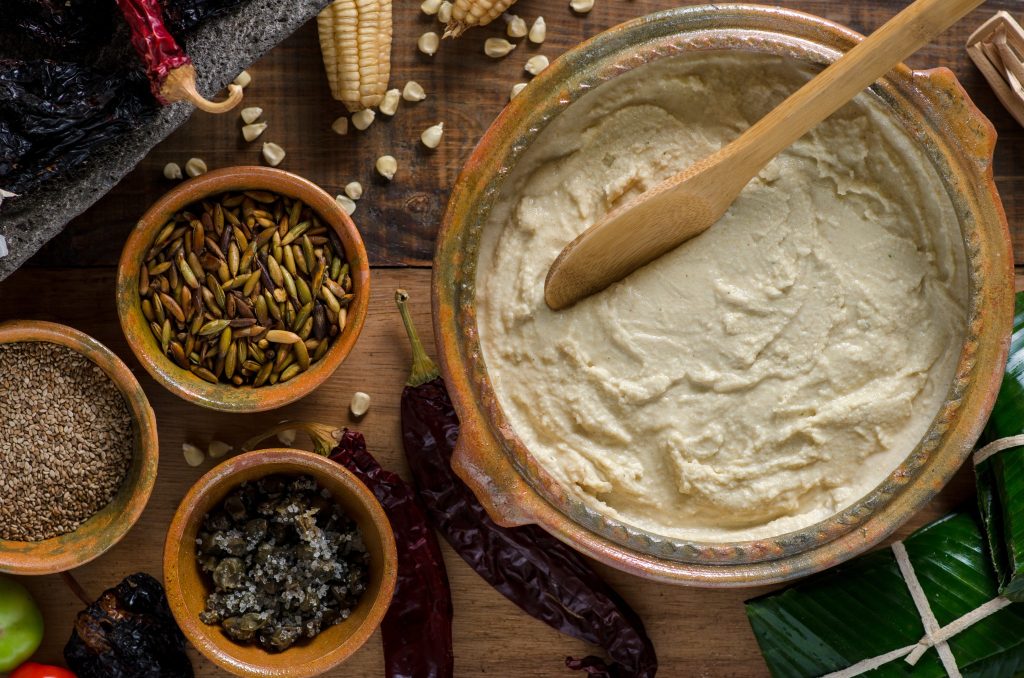
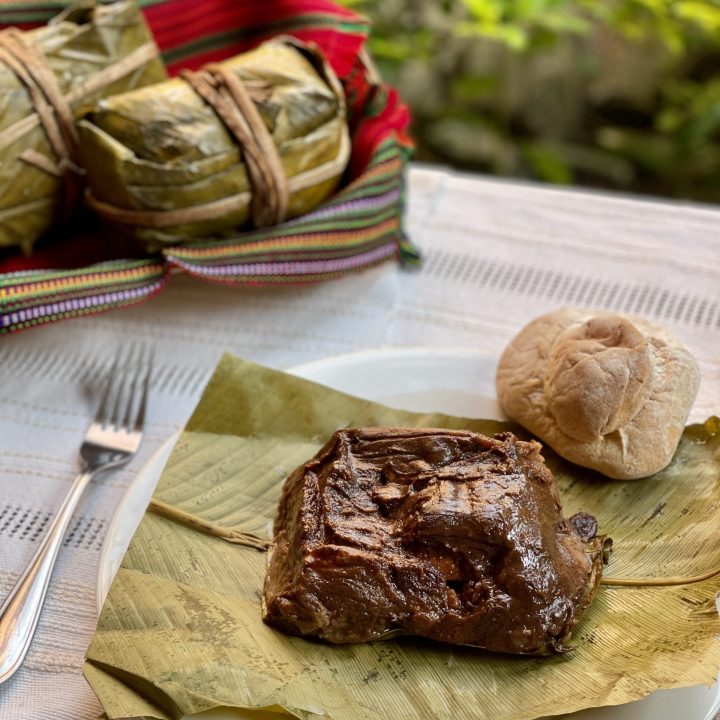
The Best Guatemalan Tamales Negros Recipe
I'm sharing my family's authentic tamal negro recipe. This recipe for traditional Guatemalan tamales negros includes easy to follow step by step instructions.
Ingredients
- For The Dough:
- 4 lb of prepared salpor corn dough (or any corn flour)
- 1 lb of prepared rice flour
- 1 ½ lb of lard
- 2 ½ lb of sugar
- 4 cups of water
- Ingredients For The Meat Filling:
- 2 lb of pork meat (or chicken)
- 1 tablespoon lard
- 1 teaspoon of salt
- 1 teaspoon of sugar
- For the Mole Sauce (Recado):
- 12 medium tomatoes
- 2 pasilla chiles
- 4 guaque chiles
- 6 whole allspice berries
- 6 black peppercorns
- 1 stick of cinnamon (or a teaspoon of ground cinnamon)
- 4 cloves
- 3 oz of pumpkin seeds
- 2 oz of sesame seeds
- 4 tablets (8 oz) of grated Mexican chocolate (like Abuelita or Ibarra)
- 2 to 3 cups of water
- 6 level tablespoons of sugar
- ½ box of raisins
- 8 prunes
- 1 teaspoon of lard
- Champurrada bread crumbs to taste (only if necessary, to thicken)
- For Assembling The Tamales:
- 30 cut banana leaves
- 30 cut maxán leaves
- 2 bunches of cibaque (string)
- 30 prunes
Instructions
For The Dough:
- Dilute the corn dough with 2 cups of water, making sure to avoid lumps, in a large bowl that allows free movement.
- Separately, in another bowl, dilute the rice flour with a cup of water until smooth.
- Combine the two diluted doughs, adding the remaining 2 cups of water.
- Cook this dough, stirring constantly to prevent it from settling and sticking to the bowl. As it boils, add the indicated lard and sugar. Cook until well done and not too hard. Let it cool down.
For The Meat:
- Cut the meat into 30 cube-shaped pieces.
Rub them with sugar and a pinch of salt. Then, fry them in a pan with a tablespoon of oil or lard. Keep them warm once done. - I recommend using boneless chicken. If using chicken, the cooking time for the meat may vary as chicken cooks faster than pork.
- However, the cooking times for the tamales will be the same.
For The Sauce:
- Roast the tomatoes, allspice, chiles (seedless), cinnamon, and cloves in a pan; peel the tomatoes and set aside. Toast the pumpkin seeds and sesame seeds separately and set aside as well.
- After roasting and toasting, blend all these with the chocolate and 2 cups of water until you get a smooth sauce.
- Add 8 prunes, half a box of raisins, and 6 tbsp of sugar. Blend again until smooth.
- Fry this mixture in the same pan as the meat using 1 tbsp, of lard.
- Check for seasoning; add ½ cup of water and let it reduce. If necessary, use bread crumbs to thicken. Cook until you get a thick sauce consistency to prevent it from running.
How To Wrap Banana Leaf Tamales:
- Bend the side of the banana leaf nearest to you over the dough, then pull the side furthest from you towards yourself. This will form a narrow, elongated rectangle.
- Gently encase the dough by folding over one of the longer edges and then the other.
Secure the package with the string, ensuring it’s snugly tied. - Continue this process with the remaining dough and leaves.
- I prefer adding an additional aluminum foil layer around the banana leaf-wrapped tamales. This extra layer aids in the storage of the cooked tamales, whether you plan to refrigerate them for a short period or freeze them for later use.
Preparing The Pot:
- Once you finish preparing the tamales, take a large pot and cover the walls and bottom with leaves (this is known as “bed”). Place them inside.
- Add boiling water until it fills ¾ of the height of the tamales. Add 1 tablespoon of sugar.
- Cover them with more leaves and a plastic bag.
Put the lid on pot and cook over medium-high heat for 50 to 60 minutes. Check the water level at 30 minutes of cooking. If necessary, add more hot water. - Once the tamales are placed on the bed, the hot water you pour into the pot
- Under no circumstances should the pot run out of water. Otherwise, the pot will burn, the tamales will come out smoked, and the wrappings will be burnt.
- After cooking and testing tamales to see “how it turned out,” let them cool a bit so that the tamales set and the dough compact.
- Otherwise, the dough will be tasty but watery. One way to know if it’s done is to take one of the tamales out of the pot and give it a pat, it should sound hollow.
Nutrition Information:
Amount Per Serving: Calories: 395
Exploring the Diversity of Guatemalan Tamales: More Guatemalan Tamal Recipes!
Derived from the Nahuatl word “tamalli,” which translates to ‘wrapped’, tamales in Guatemala exhibit a wide variety in terms of wrapping materials, sizes, fillings, and even cooking techniques.
The ‘masa’ or dough is versatile, made from corn, rice, potatoes, or a blend of these. The fillings and sauces (‘recado’) range from savory and spicy to sweeter concoctions featuring sugar, nuts, and fruits. The wrapping of tamales varies, too, with some encased in banana leaves and others in corn husks. Here’s a look at some of the most popular types of Guatemalan tamales:
- Tamales Colorados (Red Tamales): A classic choice, these tamales feature a corn-based dough filled with either pork or chicken. They’re enveloped in a rich, savory red sauce, accented with green olives and sweet red peppers, and wrapped in banana leaves.
- Tamal Negro (Black Tamale): Known for its sweet Mole-style sauce rich in chocolate, this variant is darker and sweeter than Tamales Colorados. The filling usually consists of chicken, turkey, or pork and is enhanced with raisins, almonds, and prunes. Wrapped in banana leaves, Tamal Negro is especially popular during holidays.
- Tamalitos de Elote: These tamales are unique with their sweet corn-based dough that incorporates whole sweet corn kernels, excluding any meat.
- Tamales de Masa: Smaller and simpler, these tamales are unfilled and cooked in corn husks, resulting in a thicker texture. They are commonly used as a bread substitute and dipped in soups and salsas.
- Tamalitos de Cambray: A sweet tamale made with a sweet corn-based dough and usually filled with raisins, almonds, and anise. Prepared for special events, they offer a delightful dessert option.

- Chuchitos: Featuring a thicker corn-based dough, Chuchitos are filled with chicken and a sauce similar to Tamales Colorados but are wrapped in corn husks. Smaller in size, they are a common everyday meal and a favorite at celebrations.
- Tamales de Chipilín: Similar in size to Chuchitos, these tamales include chipilín leaves, known for their unique earthy and sour flavor that becomes mild and pleasant when cooked, akin to a blend of spinach and watercress.
- Paches: Distinctively made with mashed potatoes instead of corn dough, Paches follow the traditional tamale recipe in other aspects, including meat and recado filling.
Each type of Guatemalan tamal offers a unique taste and texture, reflecting the country’s rich culinary heritage and the creativity of its cooks.
Other Traditional Guatemalan Recipes
- Guatemalan Pepian de Pollo: Pepián de pollo, or chicken pepián, is one of the oldest Guatemalan chicken recipes and Guatemala’s national dish. This Guatemalan chicken stew is rich in flavors and filled with roasted spices. Pepián can be made with chicken, beef, or pork (or a combination of these meats), stewed in a tomato-based sauce flavored with roasted seeds, and peppers.
- Traditional Guatemalan Enchiladas or Jardineras: A traditional Guatemalan dish, it is a fairly easy Guatemalan recipe. Made with a toasted tortilla topped with a vegetable mixture or escabeche, ground beef, and tomato sauce, it is one of my favorite authentic Guatemalan foods.
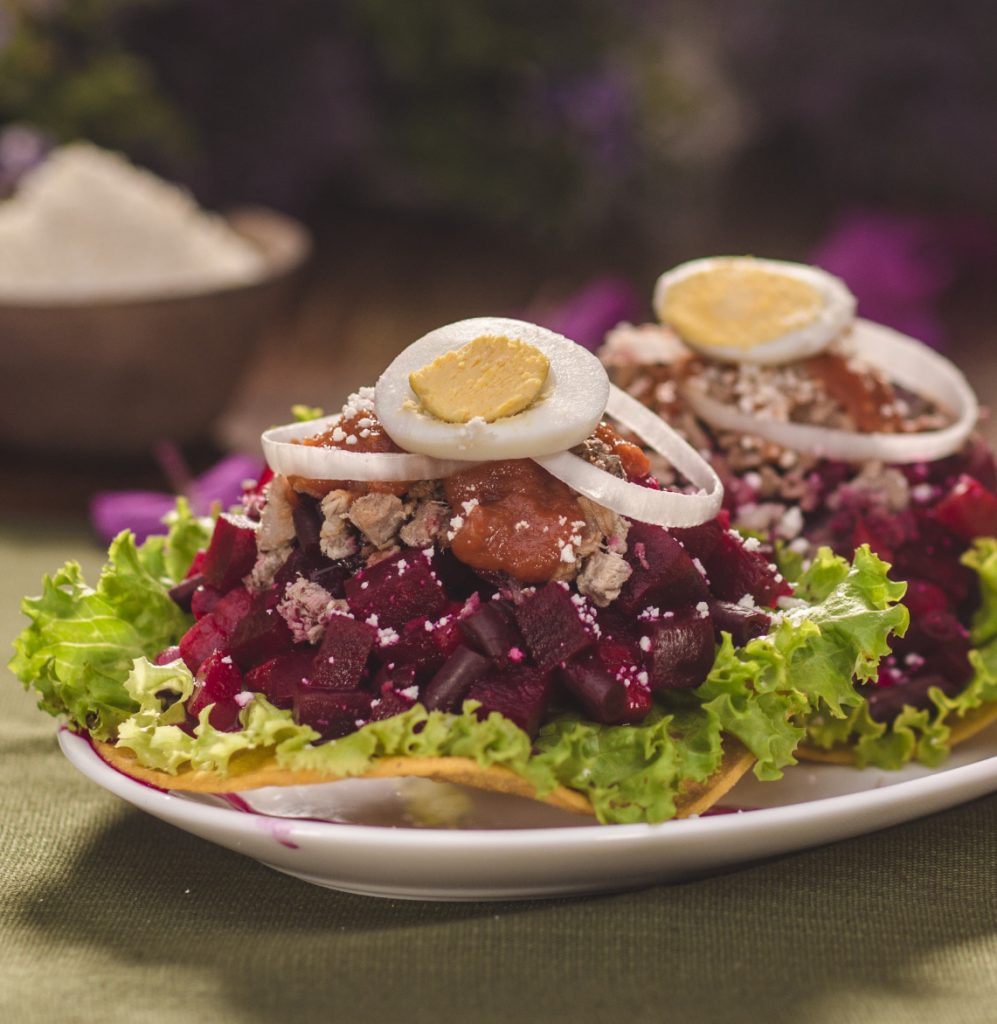
- Guatemalan Chiles Rellenos Recipe: This traditional Guatemalan recipe is somewhat different from the Mexican Chiles Rellenos. It is sweet peppers filled with a concoction of beef and veggies, and a drizzle of tomato sauce.
- Pollo En Jocón (Tomatillo Chicken Stew): This easy and healthy recipe for Pollo en Jocón, tomatillo and cilantro chicken stew, is a traditional dish from Guatemala. Delicious and easy to make, it’s the perfect cold-weather comfort food.
- Guatemalan Rellenitos: Rellenitos are made with ripe plantains, filled with beans, and covered in sugar. Although the combination might seem strange, this sweet plantain recipe is one of the most delicious Guatemalan foods.
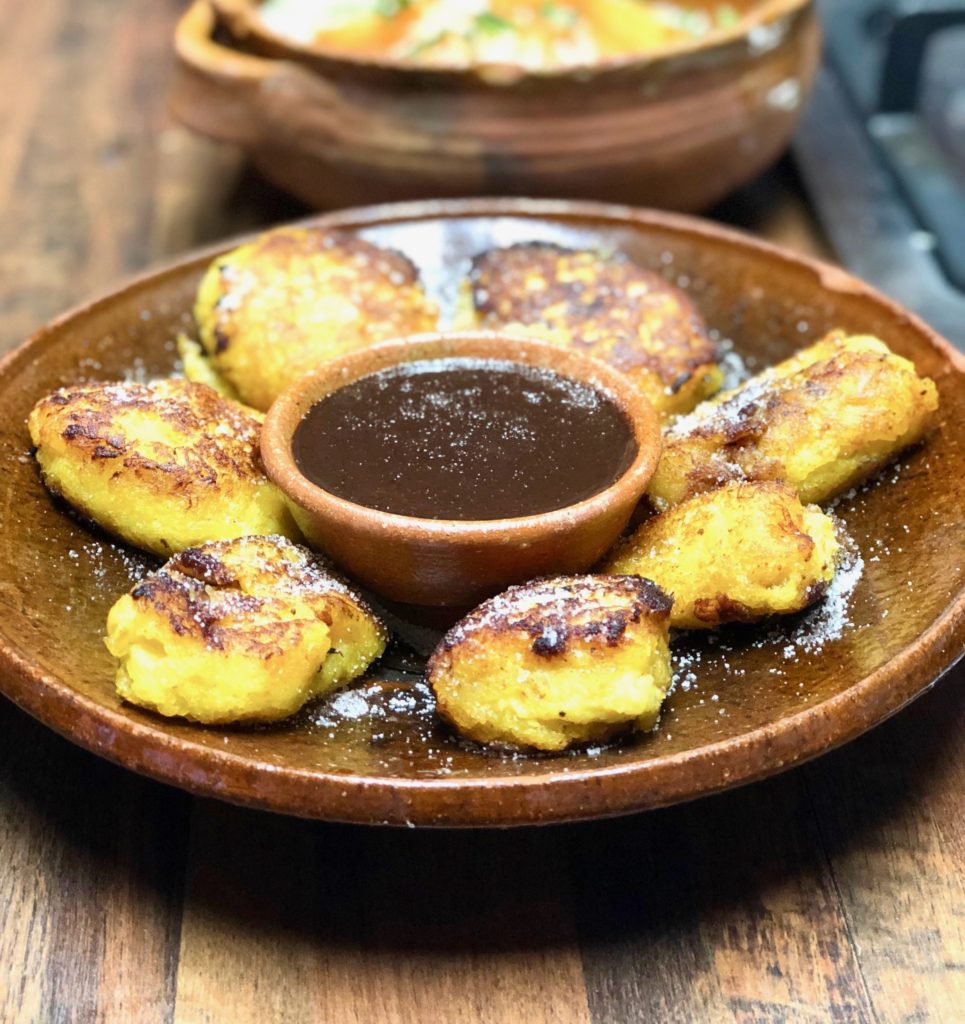
- Guatemalan Buñuelos: Buñuelos are fried wheat-based dough balls, crisp on the outside and soft on the inside, covered in white sugar, and served in a light syrup with a hint of anise.


